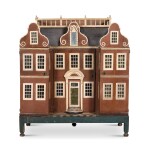Classic Design: Furniture, Silver & Ceramics
Classic Design: Furniture, Silver & Ceramics

A Rare Queen Anne Polychrome Painted Oak and Pine Child's Wardrobe in the form of a 17th-Century Anglo-Dutch Manor House, the back and one side signed and dated EDMUND JOY 1709
Lot Closed
April 16, 04:01 PM GMT
Estimate
8,000 - 12,000 USD
Lot Details
Description
on a later painted stand with turned feet; the central bay opening to reveal a central space formerly fitted with a hanging bar; the flanking bays opening to interior arrangements of shelves and drawers; the back with later pencil sketches of metalware; repairs and replacements to mullions and glass panes
height 65 in.; width 57 ¾ in.; depth 26 in.
height without stand 54 in.
165 cm.; 146.5 cm.; 66 cm; 137 cm.
Acquired from Alistair Sampson, London
The Magazine Antiques, January 1986, p.164 (advertisement)
A very similar wardrobe of larger scale and signed and dated EDMUND JOY 1712 is in the collection of the Victoria & Albert Museum, London (W.36-1930, https://collections.vam.ac.uk/item/O91201/wardrobe-joy-edmund/), formerly on view at the Museum of Childhood in Bethnal Green. Both were probably made as luxury furniture items for a nursery in a wealthy household, and the proximity of style and dates raises the possibility they were made for two children of the same family.
The hipped roofs and gables hark back to Dutch-influenced domestic architecture of the 17th century, the most notable surviving example of which is the Dutch House at Kew, a red-brick structure erected in 1631 that served as part of the royal Kew Palace in the 18th century. This style was most prevalent in London, Kent and East Anglia, and it has been suggested the maker of the wardrobes could be associated with an Edmund Joy recorded at Neatishead in Norfolk.
You May Also Like










